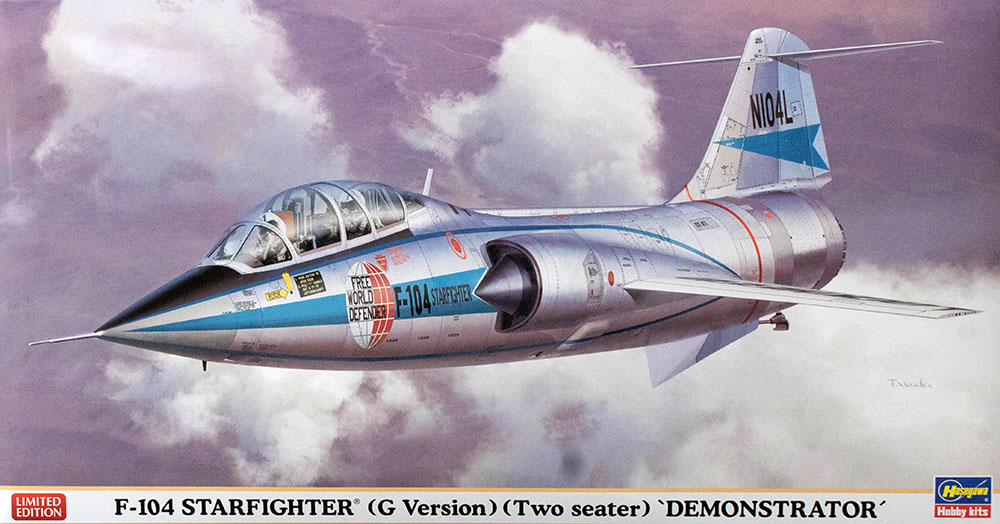
Hasegawa 1/48 TF-104G Starfighter Demonstrator Kit First Look
By Michael Benolkin
| Date of Review | January 2018 | Manufacturer | Hasegawa |
|---|---|---|---|
| Subject | TF-104G Starfighter Demonstrator | Scale | 1/48 |
| Kit Number | 07459 | Primary Media | Styrene |
| Pros | Nice kit | Cons | See text |
| Skill Level | Basic | MSRP (USD) | $54.95 |
First Look
 |
 |
 |
 |
 |
Less than five years after Chuck Yeager broke the sound barrier, Clarence 'Kelly' Johnson was looking at the first combat experience between jet fighters over the skies of Korea and understood the need for an aircraft that could reach high altitude and affect a high-speed intercept to achieve and maintain air superiority. His revolutionary Model 83 was designed to meet that need and was submitted to the USAF as an unsolicited proposal. The Air Force agreed with the need, but decided to seek other ideas from industry. Designs were submitted by Republic and North American, but a cautious Air Force staff opted for the Lockheed design. The F-104 was born. Two XF-104s were delivered less than two years later, but the first production F-104As would not enter service until early 1958. The F-104 was the first operational aircraft to fly above Mach 2 (twice the speed of sound). Its small airframe enclosed a powerful afterburning J79 engine which could take the F-104 from the ground to 80,000 feet in less than five minutes. The F-104G and its two-seat trainer variant, TF-104G, was produced as a multi-role fighter for operations in Belgium, Germany, Holland, and Italy, with each of these countries producing a combined total of over 1000 airframes. Many of these would find their way into other Air Forces including Greece.
During the early 1960s, Lockheed pulled an export two-seat Starfighter off the production line to use as a marketing demonstrator. This was TF-104G (c/n 5702) and was also used by Jacqueline Cochran to set three women's speed records in 1964. During that time, the aircraft wore US civilian registration numbers N104L and N90500. When its marketing duties were finished, the aircraft was purchased by the Royal Netherlands Air Force as D-5702 and later served with the Turkish Air Force.
Nearly two decades ago, Hasegawa released their first new-tool 1/48 F-104 Starfighter kit and from there, they've produced a number of single-seat and two-seat variants. Here is one of the popular limited edition releases featuring the Lockheed marketing color scheme. As I recall, this scheme was first released around a decade ago and it is nice to see it back. Judging by how quickly this release disappeared off of some store shelves, I'm not the only one.
The kit is molded in light gray styrene, and is impressive with its sharply-scribed detailing. It is presented on nine parts trees, plus two trees of clear parts. A number of the trees are common to the other 1/48 Starfighter releases, but the fuselage halves, the tree containing the dual cockpit, and one of the clear trees are all different tooling from the previous single-seat releases.
Among the features and options in this kit:
- Detailed front and rear cockpits (see notes)
- Positionable canopies
- Positionable speed brakes
- Positionable leading edge flaps
- Positionable trailing edge flaps
- Positionable ailerons
- Positionable rudder
- Positionable stabilator
- Bulged main gear doors
- Detailed wheel wells
The markings included in this kit are for the same aircraft:
- TF-104G, N104L, Lockheed Demonstrator
- TF-104G, N90500, Lockheed Demonstrator
Notes:
- The details start in the cockpit with each ejection seat being comprised of nine parts. No seatbelts or harnesses are molded in place, so you'll need to obtain some photo-etch to address these issues
- Decals are provided for the side consoles and instrument panels
- As this is a trainer variant, the kit only provides the tip tanks and empty underwing pylons, but only the tip tanks are used for this release
For years, the Hasegawa 1/48 Starfighters have remained the best kits in this scale. Ironically, as nice as these kits are, DACO released a sizable box of styrene containing corrections, updates, and more for the Hasegawa kits. The DACO set is the most comprehensive update I've seen for any kit and it is all styrene. Many modelers will be happy with this kit straight out of the box (and some aftermarket seatbelts).
Grab one of these limited edition kits before they disappear as this is going to be a popular subject!
My sincere thanks to HobbyLink Japan for this review sample!







